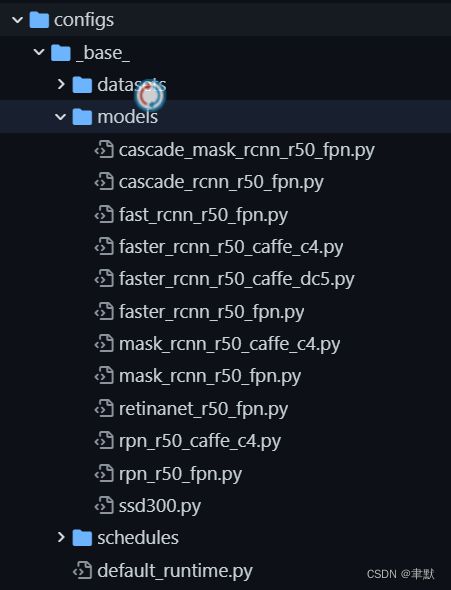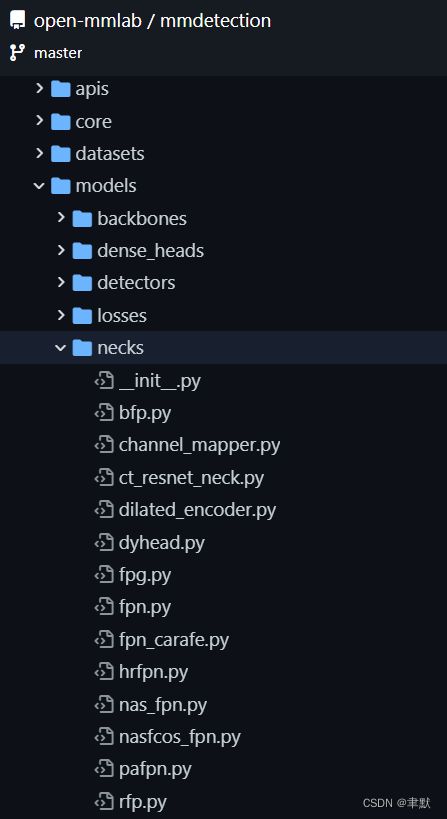【mmdetection系列】mmdetection之neck讲解
目录
1.configs
2.具体实现
3.如何调用的?
3.1 注册
3.2 调用
类似于backbone部分。
配置部分在configs/_base_/models目录下,具体实现在mmdet/models/necks目录下。
1.configs
我们看下yolox的neck吧。https://github.com/open-mmlab/mmdetection/blob/master/configs/yolox/yolox_s_8x8_300e_coco.py
neck=dict(
type='YOLOXPAFPN',
in_channels=[128, 256, 512],
out_channels=128,
num_csp_blocks=1)2.具体实现
neck作用:一般是收集到不同阶段的特征图的网络层,并将其传递到预测层。
我们可以找到YOLOXPAFPN类的具体实现:
https://github.com/open-mmlab/mmdetection/blob/master/mmdet/models/necks/yolox_pafpn.py#L14
@NECKS.register_module()
class YOLOXPAFPN(BaseModule):
"""Path Aggregation Network used in YOLOX.
Args:
in_channels (List[int]): Number of input channels per scale.
out_channels (int): Number of output channels (used at each scale)
num_csp_blocks (int): Number of bottlenecks in CSPLayer. Default: 3
use_depthwise (bool): Whether to depthwise separable convolution in
blocks. Default: False
upsample_cfg (dict): Config dict for interpolate layer.
Default: `dict(scale_factor=2, mode='nearest')`
conv_cfg (dict, optional): Config dict for convolution layer.
Default: None, which means using conv2d.
norm_cfg (dict): Config dict for normalization layer.
Default: dict(type='BN')
act_cfg (dict): Config dict for activation layer.
Default: dict(type='Swish')
init_cfg (dict or list[dict], optional): Initialization config dict.
Default: None.
"""
def __init__(self,
in_channels,
out_channels,
num_csp_blocks=3,
use_depthwise=False,
upsample_cfg=dict(scale_factor=2, mode='nearest'),
conv_cfg=None,
norm_cfg=dict(type='BN', momentum=0.03, eps=0.001),
act_cfg=dict(type='Swish'),
init_cfg=dict(
type='Kaiming',
layer='Conv2d',
a=math.sqrt(5),
distribution='uniform',
mode='fan_in',
nonlinearity='leaky_relu')):
super(YOLOXPAFPN, self).__init__(init_cfg)
self.in_channels = in_channels
self.out_channels = out_channels
conv = DepthwiseSeparableConvModule if use_depthwise else ConvModule
# build top-down blocks
self.upsample = nn.Upsample(**upsample_cfg)
self.reduce_layers = nn.ModuleList()
self.top_down_blocks = nn.ModuleList()
for idx in range(len(in_channels) - 1, 0, -1):
self.reduce_layers.append(
ConvModule(
in_channels[idx],
in_channels[idx - 1],
1,
conv_cfg=conv_cfg,
norm_cfg=norm_cfg,
act_cfg=act_cfg))
self.top_down_blocks.append(
CSPLayer(
in_channels[idx - 1] * 2,
in_channels[idx - 1],
num_blocks=num_csp_blocks,
add_identity=False,
use_depthwise=use_depthwise,
conv_cfg=conv_cfg,
norm_cfg=norm_cfg,
act_cfg=act_cfg))
# build bottom-up blocks
self.downsamples = nn.ModuleList()
self.bottom_up_blocks = nn.ModuleList()
for idx in range(len(in_channels) - 1):
self.downsamples.append(
conv(
in_channels[idx],
in_channels[idx],
3,
stride=2,
padding=1,
conv_cfg=conv_cfg,
norm_cfg=norm_cfg,
act_cfg=act_cfg))
self.bottom_up_blocks.append(
CSPLayer(
in_channels[idx] * 2,
in_channels[idx + 1],
num_blocks=num_csp_blocks,
add_identity=False,
use_depthwise=use_depthwise,
conv_cfg=conv_cfg,
norm_cfg=norm_cfg,
act_cfg=act_cfg))
self.out_convs = nn.ModuleList()
for i in range(len(in_channels)):
self.out_convs.append(
ConvModule(
in_channels[i],
out_channels,
1,
conv_cfg=conv_cfg,
norm_cfg=norm_cfg,
act_cfg=act_cfg))
def forward(self, inputs):
"""
Args:
inputs (tuple[Tensor]): input features.
Returns:
tuple[Tensor]: YOLOXPAFPN features.
"""
assert len(inputs) == len(self.in_channels)
# top-down path
inner_outs = [inputs[-1]]
for idx in range(len(self.in_channels) - 1, 0, -1):
feat_heigh = inner_outs[0]
feat_low = inputs[idx - 1]
feat_heigh = self.reduce_layers[len(self.in_channels) - 1 - idx](
feat_heigh)
inner_outs[0] = feat_heigh
upsample_feat = self.upsample(feat_heigh)
inner_out = self.top_down_blocks[len(self.in_channels) - 1 - idx](
torch.cat([upsample_feat, feat_low], 1))
inner_outs.insert(0, inner_out)
# bottom-up path
outs = [inner_outs[0]]
for idx in range(len(self.in_channels) - 1):
feat_low = outs[-1]
feat_height = inner_outs[idx + 1]
downsample_feat = self.downsamples[idx](feat_low)
out = self.bottom_up_blocks[idx](
torch.cat([downsample_feat, feat_height], 1))
outs.append(out)
# out convs
for idx, conv in enumerate(self.out_convs):
outs[idx] = conv(outs[idx])
return tuple(outs)3.如何调用的?
3.1 注册
注册创建类名字典。
@NECKS.register_module()
3.2 调用
需要从对应的YOLOX类:
mmdetection/yolox.py at master · open-mmlab/mmdetection · GitHub
然后找到实例化还是在其基类中:
mmdetection/single_stage.py at 31c84958f54287a8be2b99cbf87a6dcf12e57753 · open-mmlab/mmdetection · GitHub
self.neck = build_neck(neck)完整代码:
# Copyright (c) OpenMMLab. All rights reserved.
import warnings
import torch
from mmdet.core import bbox2result
from ..builder import DETECTORS, build_backbone, build_head, build_neck
from .base import BaseDetector
@DETECTORS.register_module()
class SingleStageDetector(BaseDetector):
"""Base class for single-stage detectors.
Single-stage detectors directly and densely predict bounding boxes on the
output features of the backbone+neck.
"""
def __init__(self,
backbone,
neck=None,
bbox_head=None,
train_cfg=None,
test_cfg=None,
pretrained=None,
init_cfg=None):
super(SingleStageDetector, self).__init__(init_cfg)
if pretrained:
warnings.warn('DeprecationWarning: pretrained is deprecated, '
'please use "init_cfg" instead')
backbone.pretrained = pretrained
self.backbone = build_backbone(backbone)
if neck is not None:
self.neck = build_neck(neck)
bbox_head.update(train_cfg=train_cfg)
bbox_head.update(test_cfg=test_cfg)
self.bbox_head = build_head(bbox_head)
self.train_cfg = train_cfg
self.test_cfg = test_cfg
def extract_feat(self, img):
"""Directly extract features from the backbone+neck."""
x = self.backbone(img)
if self.with_neck:
x = self.neck(x)
return x
def forward_dummy(self, img):
"""Used for computing network flops.
See `mmdetection/tools/analysis_tools/get_flops.py`
"""
x = self.extract_feat(img)
outs = self.bbox_head(x)
return outs
def forward_train(self,
img,
img_metas,
gt_bboxes,
gt_labels,
gt_bboxes_ignore=None):
"""
Args:
img (Tensor): Input images of shape (N, C, H, W).
Typically these should be mean centered and std scaled.
img_metas (list[dict]): A List of image info dict where each dict
has: 'img_shape', 'scale_factor', 'flip', and may also contain
'filename', 'ori_shape', 'pad_shape', and 'img_norm_cfg'.
For details on the values of these keys see
:class:`mmdet.datasets.pipelines.Collect`.
gt_bboxes (list[Tensor]): Each item are the truth boxes for each
image in [tl_x, tl_y, br_x, br_y] format.
gt_labels (list[Tensor]): Class indices corresponding to each box
gt_bboxes_ignore (None | list[Tensor]): Specify which bounding
boxes can be ignored when computing the loss.
Returns:
dict[str, Tensor]: A dictionary of loss components.
"""
super(SingleStageDetector, self).forward_train(img, img_metas)
x = self.extract_feat(img)
losses = self.bbox_head.forward_train(x, img_metas, gt_bboxes,
gt_labels, gt_bboxes_ignore)
return losses
def simple_test(self, img, img_metas, rescale=False):
"""Test function without test-time augmentation.
Args:
img (torch.Tensor): Images with shape (N, C, H, W).
img_metas (list[dict]): List of image information.
rescale (bool, optional): Whether to rescale the results.
Defaults to False.
Returns:
list[list[np.ndarray]]: BBox results of each image and classes.
The outer list corresponds to each image. The inner list
corresponds to each class.
"""
feat = self.extract_feat(img)
results_list = self.bbox_head.simple_test(
feat, img_metas, rescale=rescale)
bbox_results = [
bbox2result(det_bboxes, det_labels, self.bbox_head.num_classes)
for det_bboxes, det_labels in results_list
]
return bbox_results
def aug_test(self, imgs, img_metas, rescale=False):
"""Test function with test time augmentation.
Args:
imgs (list[Tensor]): the outer list indicates test-time
augmentations and inner Tensor should have a shape NxCxHxW,
which contains all images in the batch.
img_metas (list[list[dict]]): the outer list indicates test-time
augs (multiscale, flip, etc.) and the inner list indicates
images in a batch. each dict has image information.
rescale (bool, optional): Whether to rescale the results.
Defaults to False.
Returns:
list[list[np.ndarray]]: BBox results of each image and classes.
The outer list corresponds to each image. The inner list
corresponds to each class.
"""
assert hasattr(self.bbox_head, 'aug_test'), \
f'{self.bbox_head.__class__.__name__}' \
' does not support test-time augmentation'
feats = self.extract_feats(imgs)
results_list = self.bbox_head.aug_test(
feats, img_metas, rescale=rescale)
bbox_results = [
bbox2result(det_bboxes, det_labels, self.bbox_head.num_classes)
for det_bboxes, det_labels in results_list
]
return bbox_results
def onnx_export(self, img, img_metas, with_nms=True):
"""Test function without test time augmentation.
Args:
img (torch.Tensor): input images.
img_metas (list[dict]): List of image information.
Returns:
tuple[Tensor, Tensor]: dets of shape [N, num_det, 5]
and class labels of shape [N, num_det].
"""
x = self.extract_feat(img)
outs = self.bbox_head(x)
# get origin input shape to support onnx dynamic shape
# get shape as tensor
img_shape = torch._shape_as_tensor(img)[2:]
img_metas[0]['img_shape_for_onnx'] = img_shape
# get pad input shape to support onnx dynamic shape for exporting
# `CornerNet` and `CentripetalNet`, which 'pad_shape' is used
# for inference
img_metas[0]['pad_shape_for_onnx'] = img_shape
if len(outs) == 2:
# add dummy score_factor
outs = (*outs, None)
# TODO Can we change to `get_bboxes` when `onnx_export` fail
det_bboxes, det_labels = self.bbox_head.onnx_export(
*outs, img_metas, with_nms=with_nms)
return det_bboxes, det_labels
